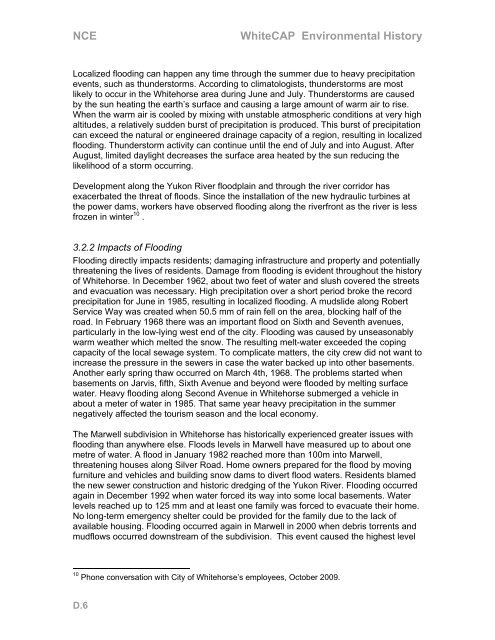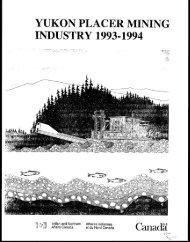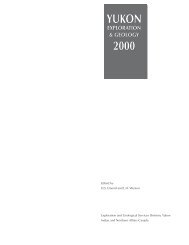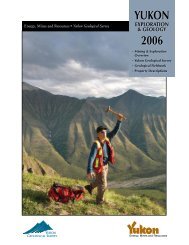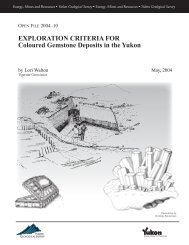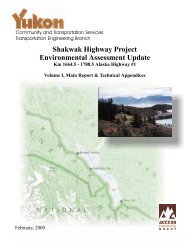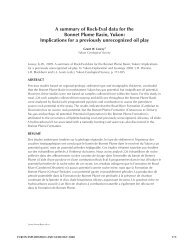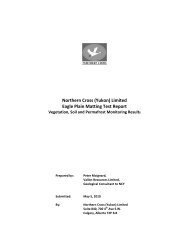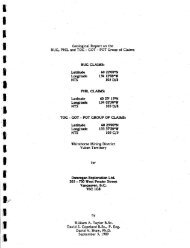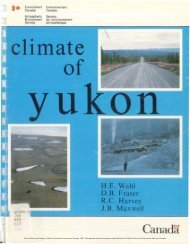WhiteCAP_Plan_01SEPT..
WhiteCAP_Plan_01SEPT..
WhiteCAP_Plan_01SEPT..
You also want an ePaper? Increase the reach of your titles
YUMPU automatically turns print PDFs into web optimized ePapers that Google loves.
NCE <strong>WhiteCAP</strong> Environmental History<br />
Localized flooding can happen any time through the summer due to heavy precipitation<br />
events, such as thunderstorms. According to climatologists, thunderstorms are most<br />
likely to occur in the Whitehorse area during June and July. Thunderstorms are caused<br />
by the sun heating the earth’s surface and causing a large amount of warm air to rise.<br />
When the warm air is cooled by mixing with unstable atmospheric conditions at very high<br />
altitudes, a relatively sudden burst of precipitation is produced. This burst of precipitation<br />
can exceed the natural or engineered drainage capacity of a region, resulting in localized<br />
flooding. Thunderstorm activity can continue until the end of July and into August. After<br />
August, limited daylight decreases the surface area heated by the sun reducing the<br />
likelihood of a storm occurring.<br />
Development along the Yukon River floodplain and through the river corridor has<br />
exacerbated the threat of floods. Since the installation of the new hydraulic turbines at<br />
the power dams, workers have observed flooding along the riverfront as the river is less<br />
frozen in winter 10 .<br />
3.2.2 Impacts of Flooding<br />
Flooding directly impacts residents; damaging infrastructure and property and potentially<br />
threatening the lives of residents. Damage from flooding is evident throughout the history<br />
of Whitehorse. In December 1962, about two feet of water and slush covered the streets<br />
and evacuation was necessary. High precipitation over a short period broke the record<br />
precipitation for June in 1985, resulting in localized flooding. A mudslide along Robert<br />
Service Way was created when 50.5 mm of rain fell on the area, blocking half of the<br />
road. In February 1968 there was an important flood on Sixth and Seventh avenues,<br />
particularly in the low-lying west end of the city. Flooding was caused by unseasonably<br />
warm weather which melted the snow. The resulting melt-water exceeded the coping<br />
capacity of the local sewage system. To complicate matters, the city crew did not want to<br />
increase the pressure in the sewers in case the water backed up into other basements.<br />
Another early spring thaw occurred on March 4th, 1968. The problems started when<br />
basements on Jarvis, fifth, Sixth Avenue and beyond were flooded by melting surface<br />
water. Heavy flooding along Second Avenue in Whitehorse submerged a vehicle in<br />
about a meter of water in 1985. That same year heavy precipitation in the summer<br />
negatively affected the tourism season and the local economy.<br />
The Marwell subdivision in Whitehorse has historically experienced greater issues with<br />
flooding than anywhere else. Floods levels in Marwell have measured up to about one<br />
metre of water. A flood in January 1982 reached more than 100m into Marwell,<br />
threatening houses along Silver Road. Home owners prepared for the flood by moving<br />
furniture and vehicles and building snow dams to divert flood waters. Residents blamed<br />
the new sewer construction and historic dredging of the Yukon River. Flooding occurred<br />
again in December 1992 when water forced its way into some local basements. Water<br />
levels reached up to 125 mm and at least one family was forced to evacuate their home.<br />
No long-term emergency shelter could be provided for the family due to the lack of<br />
available housing. Flooding occurred again in Marwell in 2000 when debris torrents and<br />
mudflows occurred downstream of the subdivision. This event caused the highest level<br />
10 Phone conversation with City of Whitehorse’s employees, October 2009.<br />
D.6


